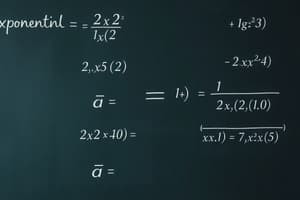Podcast
Questions and Answers
If y = log_b(x), what is the inverse relationship with exponential functions?
If y = log_b(x), what is the inverse relationship with exponential functions?
- y = x^b
- x = b^y (correct)
- y = b^x
- x = y^b
What is the domain of a logarithmic function?
What is the domain of a logarithmic function?
- (0, ∞) (correct)
- (-∞, 0)
- (-∞, ∞)
- [0, ∞)
What is the range of a logarithmic function?
What is the range of a logarithmic function?
- (-∞, ∞) (correct)
- (0, ∞)
- [0, ∞)
- (-∞, 0)
How can logarithmic functions be used to solve equations involving exponentials and logarithms?
How can logarithmic functions be used to solve equations involving exponentials and logarithms?
In the equation $y = ext{log}_b(x)$, what does $b$ represent?
In the equation $y = ext{log}_b(x)$, what does $b$ represent?
What is the domain of the function $y = \[log_2(x)]$?
What is the domain of the function $y = \[log_2(x)]$?
To evaluate $\[log_4(16)]$, you can rewrite it as
To evaluate $\[log_4(16)]$, you can rewrite it as
If $5^x = 125$, the equation in terms of logarithm becomes
If $5^x = 125$, the equation in terms of logarithm becomes
To graph the function $y = \[log_4(x+1)]$, you would observe that the shape of the graph is
To graph the function $y = \[log_4(x+1)]$, you would observe that the shape of the graph is
What is the range of the function $f(x) = \[log_3(x-2)]$?
What is the range of the function $f(x) = \[log_3(x-2)]$?
Flashcards are hidden until you start studying
Study Notes
Advanced Functions: Logarithmic Functions
Logarithmic functions are advanced functions that are used to represent the logarithm of a number with a specific base. These functions are often used in various mathematical and real-world applications, such as solving exponential equations and representing the inverse of exponential functions. In this article, we will explore the properties and characteristics of logarithmic functions, their relationship with exponential functions, and how to manipulate and evaluate them.
Properties and Characteristics of Logarithmic Functions
Logarithmic functions can be represented in the form $$y = \log_b(x)$$, where $$b$$ is the base of the logarithm and $$x$$ is the number being logged. Some key properties and characteristics of logarithmic functions include:
-
Domain and Range: The domain of a logarithmic function is $$(0, \infty)$$, meaning it can only take positive values. The range of a logarithmic function is $$(-\infty, \infty)$$, as it can take both negative and positive values.
-
Inverse Relationship: Logarithmic and exponential functions are inverses of each other. This means that if $$y = \log_b(x)$$, then $$b^y = x$$, and vice versa.
-
Logarithmic Equations: Logarithmic functions can be used to solve equations involving exponentials and logarithms. For example, if $$y = \log_b(x)$$, then $$b^y = x$$.
Graphing Logarithmic Functions
To graph a logarithmic function, you can follow these general steps:
-
Identify the base of the logarithm ($$b$$) and the number being logged ($$x$$).
-
Determine the domain and range of the function, which are given by the base and the number being logged, respectively.
-
Plot the points on the graph corresponding to the given function and observe the shape of the graph.
For example, let's consider the function $$y = \log_3(x)$$. The base of the logarithm is 3, and the number being logged is $$x$$. The domain of this function is $$(0, \infty)$$, and the range is $$(-\infty, \infty)$$. To graph this function, you would plot the points on the graph corresponding to the function and observe the shape of the graph, which would be a straight line with a slope of 1/3.
Evaluating Logarithmic Expressions
To evaluate logarithmic expressions, you can use the inverse relationship between logarithmic and exponential functions. For example, if you need to evaluate $$\log_3(9)$$, you can rewrite it as $$3^{\log_3(9)}$$, which is equal to 2. The general formula for evaluating logarithmic expressions is:
$$\log_b(x) = \log_c(x) \cdot \log_c(b)$$
For example, to evaluate $$\log_3(9)$$, you can rewrite it as $$\log_2(9) \cdot \log_2(3)$$, and then use the properties of logarithms to simplify the expression.
Solving Exponential and Logarithmic Equations
Logarithmic functions can be used to solve equations involving exponentials and logarithms. For example, if you have the equation $$3^y = x$$, you can rewrite it as $$\log_3(3^y) = \log_3(x)$$, which simplifies to $$y = \log_3(x)$$. This is an example of a logarithmic equation, which can be solved using the properties and characteristics of logarithmic functions.
In conclusion, logarithmic functions are advanced functions that have various applications in mathematics and real-world problems. Understanding their properties, relationships with exponential functions, and graphing techniques can help you manipulate and solve equations involving these functions.
Studying That Suits You
Use AI to generate personalized quizzes and flashcards to suit your learning preferences.




